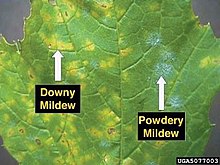any of various fungi of the genus Erysiphe producing powdery conidia that appear as a white. fuzzy coating on the upper leaf surfaces. often causing distortion of the leaf.
Powdery mildew is a fungal disease that affects a wide range of plants. Powdery mildew diseases are caused by many different species of ascomycete fungi in the order Erysiphales. Powdery mildew is one of the easier plant diseases to identify, as its symptoms are quite distinctive. Infected plants display white powdery spots on the leaves and stems. The lower leaves are the most affected, but the mildew can appear on any above-ground part of the plant. As the disease progresses, the spots get larger and denser as large numbers of asexual spores are formed, and the mildew may spread up and down the length of the plant.
| Powdery mildew | |
|---|---|
 Example of powdery mildew (right) along with Downy mildew on a grape leaf | |
| Causal agents | Species of fungi in the orders Erysiphales |
| Hosts | plants |
Powdery mildew grows well in environments with high humidity and moderate temperatures.[citation needed] Greenhouses provide an ideal moist, temperate environment for the spread of the disease. This causes harm to agricultural and horticultural practices where powdery mildew may thrive in a greenhouse setting. In an agricultural or horticultural setting, the pathogen can be controlled using chemical methods, bio-organic methods, and genetic resistance. It is important to be aware of powdery mildew and its management as the resulting disease can significantly reduce important crop yields.



